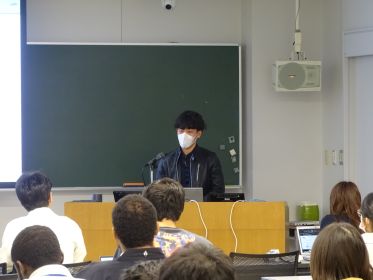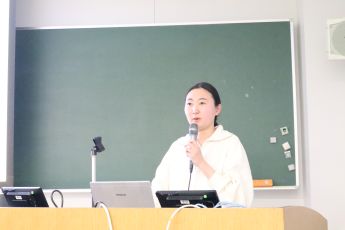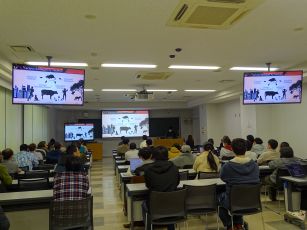- Home
- Student Activity
- Student Monthly Progress#16
The 16th Student Monthly Progress was held on November 28th, 2024.
Four students introduced their research.
【発表者】
1. KOIDE Masashi:Laboratory of Toxicology
<Assessment of effects on endangered species in the Bonin islands caused by deployment of anticoagulant rodenticide>
2. WATANUKI Shu:Laboratory of Pharmacology
<Upscaling Viral Infectious Disease Monitoring and Surveillance with Metagenomic Next Generation Sequencing Enhanced by a Group Testing Algorithm (mEGA)>
3. IKEHATA Mari:Laboratory of Infectious Diseases
<Neurotrophin-3 regulates the proliferation of pre-adipocytes in mice>
4. EDIDI Francois Atani : Division of Global Epidemiology
<Comparison of biological properties of bat-derived filovirus envelope glycoproteins>
【Chiar】
VALCORZA Paul Jr. Dera Cruz : Laboratory of Comparative Pathology
YANG Zibo : Laboratory of Biochemistry

❖Chairperson’s Report❖

Assessment of effects on endangered species in the Bonin islands caused by deployment of anticoagulant rodenticide
KOIDE Masashi
The Bonin Islands are an island group in Japan with a unique ecosystem with many endemic plants and animals. Some animals on the islands such as the Bonin fruit bat (Pteropus pselaphon) and Bonin greenfinch (Chloris sinica kittlitzi), are listed as endangered species by the IUCN. One factor threatening these species’ survival is ecosystem disturbance caused by non-native rodents like the Black rats (Rattus rattus). Diphacinone, an anticoagulant rodenticide (AR), has been used to control these rodents on the islands. However, the potential effects of rodenticides on non-target animals in this area are still unclear. ARs inhibit the blood coagulation system by blocking vitamin K epoxide reductase (VKOR), ultimately causing fatal hemorrhage, while it is also metabolized by Cytochrome P450 (CYP) in the liver. Sensitivity to ARs is species-specific, thus, he aims to assess the sensitivity of these endangered species to anticoagulant rodenticides through the binding affinity to the target molecule VKOR and the ability of CYP to metabolize ARs. In his study, he purified microsomal fractions from the livers of Oriental greenfinches (Chloris sinica minor), as an alternative to Bonin greenfinch, and of Bonin fruit bats. With the use of these microsomal fractions, inhibition tests of VKOR activity using Warfarin and Diphacinone were conducted. To assess in vitro susceptibility to rodenticides, Warfarin metabolic tests were also performed. He found out that both bats and greenfinches could have sensitivities to ARs similar to those of rats, emphasizing the need for careful consideration of AR deployment on the islands.

Astrocyte process retraction via α2-adrenoceptor
WATANUKI Shu
Astrocytes are characterized by complex morphology and numerous processes, which are related to the physiology and pathogenesis of the CNS. It has been established that astrocyte morphology is altered by various transmitters. However, it is not yet known whether α2-adrenoceptors regulate astrocyte morphology; thus, he is investigating the effects of dexmedetomidine, an α2-adrenoceptor agonist sedative. Mice were injected with dexmedetomidine and α2-adrenoceptor antagonist atipamezole. He found out that the α2-adrenoceptor agonist decreased several astrocyte morphological parameters such as territory in a concentration-dependent manner in contrast with the antagonist. Furthermore, he treated primary astrocyte cultures and acute hippocampal slices with dexmedetomidine and stained with GFAP, an astrocyte marker, to evaluate its morphological parameters. He was able to demonstrate that dexmedetomidine also inhibited β-adrenoceptor agonist-induced branch formation in primary cultured astrocytes, whereas a contrasting effect was observed in acute hippocampal slices.

Enhancement of vaccine-induced T-cell responses by feeding probiotics in calves
IKEHATA Mari
Neonates like calves, have immature immune systems, making vaccination essential to protect them from infectious diseases. However, significant individual differences in response to vaccines pose inadequate herd immunity. Therefore, it is necessary to develop strategies to enhance the protective efficacy of vaccines, particularly targeting low responders to vaccines. Probiotics have attracted attention due to their beneficial immunomodulatory effects on humans. Although feeding probiotics has been suggested to improve the immunity of calves, its mechanism is still poorly explained. Her study aims to investigate whether the immune responses, especially T-lymphocytes, to vaccination, are enhanced in calves when given a combination of probiotics feeding with vaccination. They vaccinated calves with a commercial live-attenuated viral vaccine (Calfwin6) and fed either butyric acid bacteria feed (BAB) or live bacteria-mixed feed (Zeosapo). T-cell responses to one of the vaccine antigens, bovine respiratory syncytial virus (BRSV), were then assessed by analyzing the expression of lymphocyte activation markers CD25 and CD69, and the production of Th1 cytokines in PBMC culture assays after the prime and booster vaccinations in all feeding groups. The ratio of CD25+CD69+ cells in CD4+ T cells and weight gain were significantly increased after the booster vaccination in BAB-fed and Zeosapo-fed groups. Moreover, the production of Th1 cytokines, such as IFN-γ and TNF-α, was increased after the booster vaccination in the BAB-fed group. Her clinical study demonstrates that feeding probiotics enhances CD4+ T-cell and Th1 responses to vaccination in calves. Thus, probiotics are expected to strengthen the protective efficacy of vaccines in calves.

Comparison of biological properties of bat-derived filovirus envelope glycoproteins
EDIDI Francois Atani
Filoviruses are known to be highly pathogenic and cause severe diseases in humans and nonhuman primates, mainly in Africa. With the recent development of next-generation sequencing, novel filoviruses have been detected or isolated from bats: Lloviu virus (LLOV) in Europe, Bombali virus (BOMV) in Africa, and Mengla virus (MLAV) and Dehong virus (DEHV) in China. The filovirus envelope glycoproteins (GPs) play a major role in viral entry, pathogenicity, host range, and are the main target of neutralizing antibodies. In his study, he aims to characterize the biological properties of bat-derived filovirus GPs. They generated virus-like particles (VLPs) to study their morphology and to produce mouse antisera for antigenic comparison. VLPs containing bat-derived filovirus GPs showed a filamentous shape with arrayed spikes on their surfaces while the mouse antisera to the virus showed high specificity with limited cross-reactivity to other viruses in ELISA. Vesicular stomatitis viruses (VSVs) containing the GFP gene, pseudotyped with filovirus GPs were generated to examine the interaction of GPs with attachment factors on human cell surfaces (hTIM1, DC-SIGN, and hMGL), the susceptibility of various mammalian cell lines, and cross-neutralizing activities of monoclonal antibodies (mAbs) against Ebola virus (EBOV) and Marburg virus (MARV). All of the VSVs pseudotyped with bat-derived filovirus GPs were found to use hTIM1, DC-SIGN, and hMGL for cell entry, whereas LLOV GP showed a higher ability to use these molecules than BOMV, MLAV, and DEHV. While the pseudotyped viruses showed a broad cell tropism with a higher affinity to human cell lines, BOMV GP had the highest ability to infect cell lines derived from Mops condylurus. These bat species are likely to harbor BOMV. They also found that some of the anti-EBOV or anti-MARV mAbs neutralized VSVs pseudotyped with bat-derived GPs. They were able to demonstrate that these bat-derived filoviruses are likely to be morphologically similar to EBOV and MARV, where their GPs are antigenically distinct but cross-neutralization is achievable by some mAbs. Consistent with their phylogenetic relationship, LLOV and BOMV GPs seem to be biologically closer to EBOV than to MARV, whereas MLAV and DEHV are better related to MARV than to EBOV.



